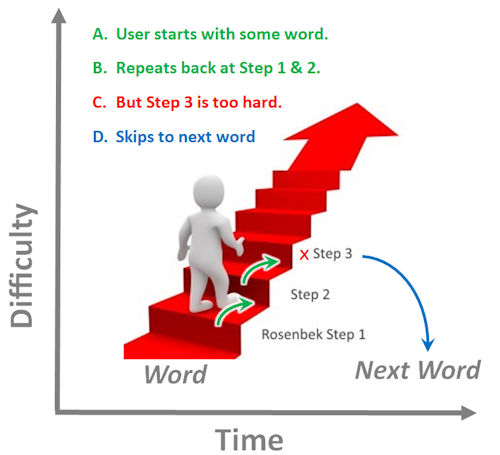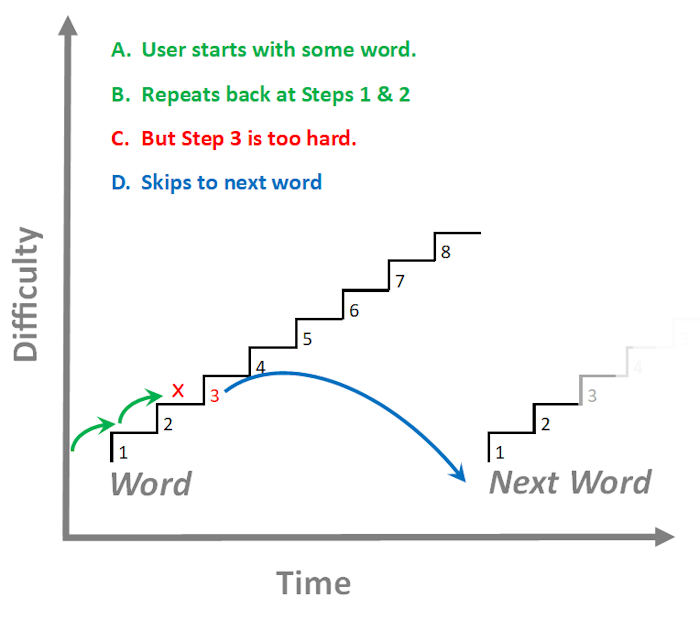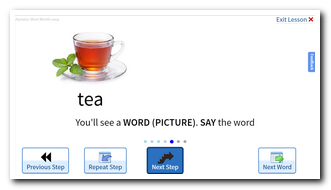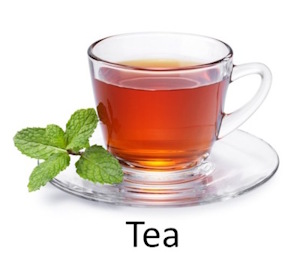Rosenbek Hierarchy of Apraxia Drills
Help your patient speak more clearly.
Clinically proven, 8-step method to help patients at home or in the clinic.
Why Apraxia can feel like a brick wall
 Apraxia causes difficulty moving the mouth & tongue to produce speech.
Apraxia causes difficulty moving the mouth & tongue to produce speech.
We use speech so often (and so effortlessly) that we forget just how complex and difficult it is to learn. If you've ever tried to teach a baby to speak, you know it's not easy. In addition, apraxia is often accompanied by expressive aphasia, causing difficulty with word-retrieval (thinking of the right word). I call that the double-whammy because you have difficulty thinking of the word and then, even if you think of it, you have trouble saying it.
Just as babies need to crawl before they can walk, and walk before they can run, stroke survivors need to break apraxia treatment into smaller steps.
Note: this is a layperson's explanation for our non-therapist readers. The proper understanding of Apraxia would fill a textbook.
Try Harder is not the answer
The Rosenbek Hierarchy breaks speech into easier steps that take the survivor from being able to repeat the word with assistance to speaking the word independently in a real-world situation.
Imagine you are trying to get over a 5-foot wall. You can't jump 5 ft straight up no matter how hard you try. The solution is not to jump higher, but, rather, to get a ladder! You've broken down the impossible problem of 5 feet into a series (a continuum) of achievable 6 inch steps. Literally. Dr. Rosenbek provided similar steps for acquired apraxia of speech treatment.

The Rosenbek Hierarchy breaks apraxia therapy into small, achievable steps
How the Rosenbek Continuum works
The Rosenbek Method is a continuum from "lots of assistance" to "less" and finally "no assistance". It was developed by John C. Rosenbek and his colleagues in the 70's. It's sometimes called Integral Stimulation because it integrates sensory cues: seeing a picture and the word, seeing and hearing the therapist model the word.

For each word:
- Step 1, with lots of assistance.
They see and hear someone speaking the word. They see the text and a picture. If they can complete the step (repeating the word back clearly) then they go to the next step for the word. If not, they go to the next word. - If they complete that step (speak the word clearly), go to next Step. Each step has less assistance to make it more challenging.
- If they cannot speak the word, go to the next word. (Step-by-step instructions below).
- Continue until they get to the last Step (#8) where they will repeat the word back with no assistance.
Visual Example of Rosenbek 8-step Hierarchy

Step-by-step instructions for the Rosenbek Continuum | |||
| Therapist (or Caregiver) Cues | Survivor Responds | ||
| 1 | Demonstrate ( Integral Stimulation) | Watches demonstration then repeats in unison with the therapist 5 times. | |
| 2 | Demonstrate, then pause and demonstrate silently (mouthing the word)  | Repeats back while watching silent demonstration. | |
| 3 | Demonstrate, then pause for survivor to repeat back without assistance. | Repeats back seeing only picture and text. | |
| 4 | Same as #3 | Same as #3 but require 5 independent repetitions. I.e.., Repeats back 5 times with only picture and text. | |
| 5 | Show the written word and picture | Names the picture | |
| 6 | Show the written word and picture, then hide them, and prompt patient to say word. | Names the picture from memory | |
| 7 | Prompt with a question I'd like a cup of herbal_____  | Answers the question with a single word (the Target word) | |
| 8 | OPTIONAL: Role play a situation that would elicit the word from the survivor. This can be difficult for some caregivers who lack acting skills. | Speaks the word in response to the situation. | |
| 9 | OPTIONAL: Appropriate response in true life situation. I included it here only because it's in the original research paper. This can be a bit difficult to arrange in therapy. | Speaks the word in response to the situation. | |
Practice the Rosenbek therapy online
 The web-based app, MoreSpeech.com, contains an Apraxia Skill area which is based on the above approach, in an easy to use treatment. If you currently seeing a speech therapist, we highly recommend you show it to them and see how best to fit it into your treatment.
The web-based app, MoreSpeech.com, contains an Apraxia Skill area which is based on the above approach, in an easy to use treatment. If you currently seeing a speech therapist, we highly recommend you show it to them and see how best to fit it into your treatment.
Speech Sounds On Cue includes feedback
If the patient wants to work independently and doesn't realize when they are misarticulating, another option is Speech Sounds On Cue which is included in our Monthly Subscription.
Video of Rosenbek's Hierarchy of Integral Stimulation
Demonstrated by speech-pathology grad student
Clinician-oriented video of Rosenbek's Hierarchy, including research basis
Free Treatment materials
- Printable Worksheets (Aphasia, Apraxia, Writing, Reading, Auditory Comprehension)
- Clinically proven treatment protocols you can use today.
- Clever Cognitive therapy activity with guaranteed carryover
- And more, delivered free every week.
Footnotes and Research Summary
The Apraxia of Speech protocol developed for the MoreSpeech.com app is based on accepted and commonly conducted clinical practice and research articles demonstrating improved outcomes published in peer-reviewed professional journals including the seminal work "A Treatment for Apraxia of Speech in Adults"
The treatment used in the MoreSpeech app incorporates the stimulation/facilitation model. Duffy & Coelho (2001) provides an excellent description and analysis of Schuell (1953, 1964, 1974) original theory and the subsequent work of researchers who support the concepts that:
- Sensory stimulation influences brain activity;
- Repetition of sensory stimulation is needed for acquisition, organization, and retrieval of patterns of behavior;
- The auditory modality is central to acquisition and maintenance of language;
- The auditory modality is severely compromised for most aphasic people; and
- If aphasia is defined as a multimodal language impairment, then intense stimulation treatment should be directed through the auditory modality because of its essential role in language processing.
Research on Treatment approaches to apraxia
Rosenbek, J. C., Lemme, M. L., Ahern, M. B., Harris, E. H., & Wertz, R. T. (1973). A treatment for apraxia of speech in adults. Journal of Speech and Hearing Disorders, 38, 462–472.Schuell, H. (1953). Auditory impairment in aphasia: Significance and retraining techniques. Journal of Speech and Hearing Disorders, 18, 14-21.Schuell, H., Jenkins, J. J., & Jiménez-Pabón, E. (1964). Aphasia In Adults. New York: Harper & Row.
Wambaugh, Julie L., Doyle, Patrick J., Treatment for Acquired Apraxia of Speech: A Review of Efficacy Reports, Clinical Aphasiology; Vol. 22, 1994, pp 231-243
Rosenbek J. C., Wertz, R. T., Darley, Oral Sensation and Perception in Apraxia of Speech and Aphasia, Journal of Speech, Language, and Hearing Research
Schuell, H. (1974). Aphasia theory and therapy: Selected lectures and papers of Hildred Schuell (Sies, L. F., Ed.). Baltimore: University Park Press
Every day is an opportunity for recovery. Don't miss a single day.
- Surprising neuroscience discovery that makes recovery possible at any age.
- Why embracing failure leads to faster recovery.
- Unlock your survivor's communication needs in 4 steps.
- How to improve speech & language at the kitchen table.
Clay Nichols
Co-founder of MoreSpeech and Bungalow Software for unlimited speech therapy at home and in the clinic.
 For 3 decades, Clay has helped patients, caregivers and speech pathologists with & language softwspeech are. He shares the tips & tricks he's picked up along the way. He is not a speech therapst. Consult your speech therapist regarding any tips you read anywhere, including the Rehab Resources.
For 3 decades, Clay has helped patients, caregivers and speech pathologists with & language softwspeech are. He shares the tips & tricks he's picked up along the way. He is not a speech therapst. Consult your speech therapist regarding any tips you read anywhere, including the Rehab Resources.
© 2025 Bungalow Software
